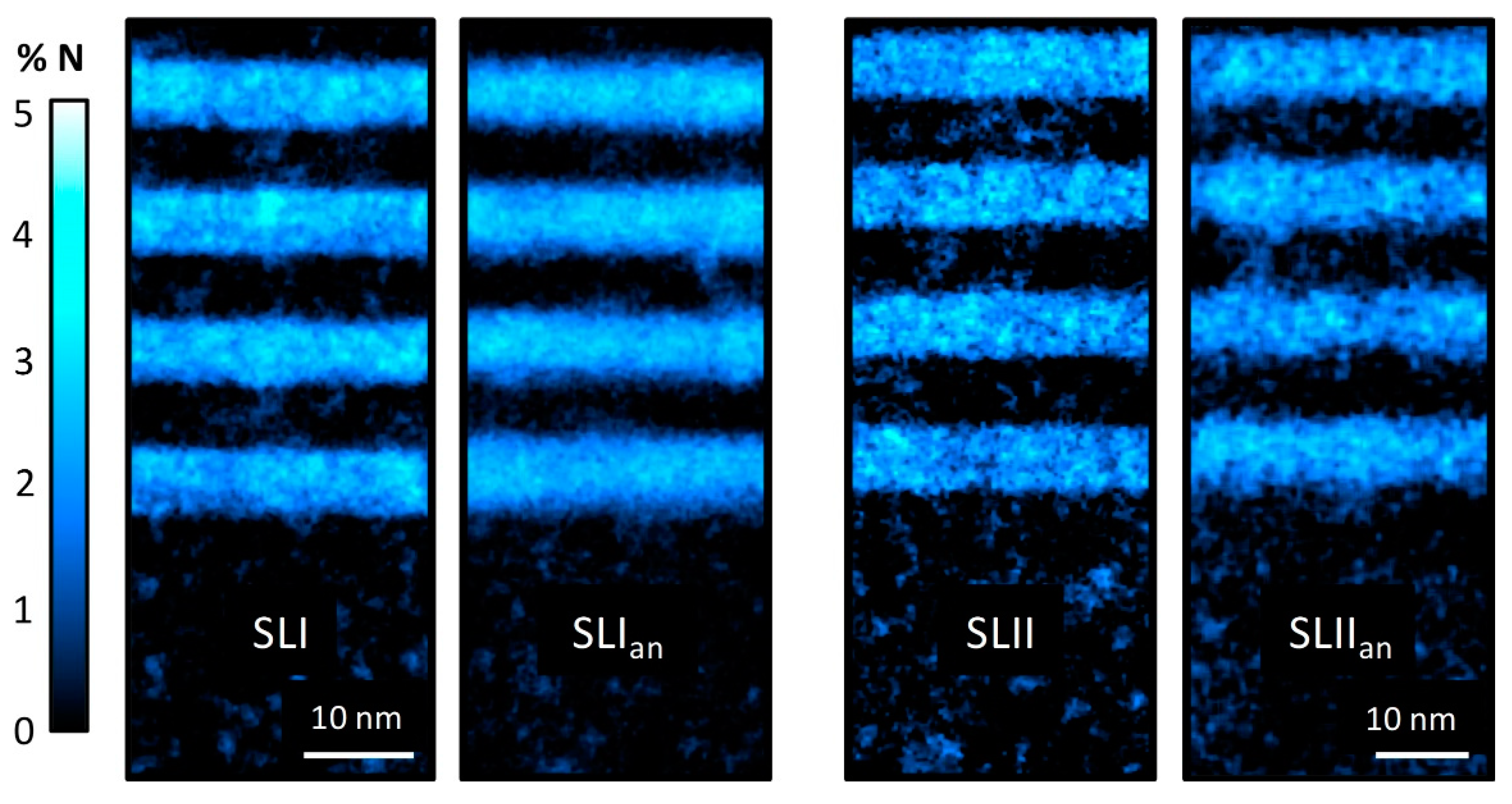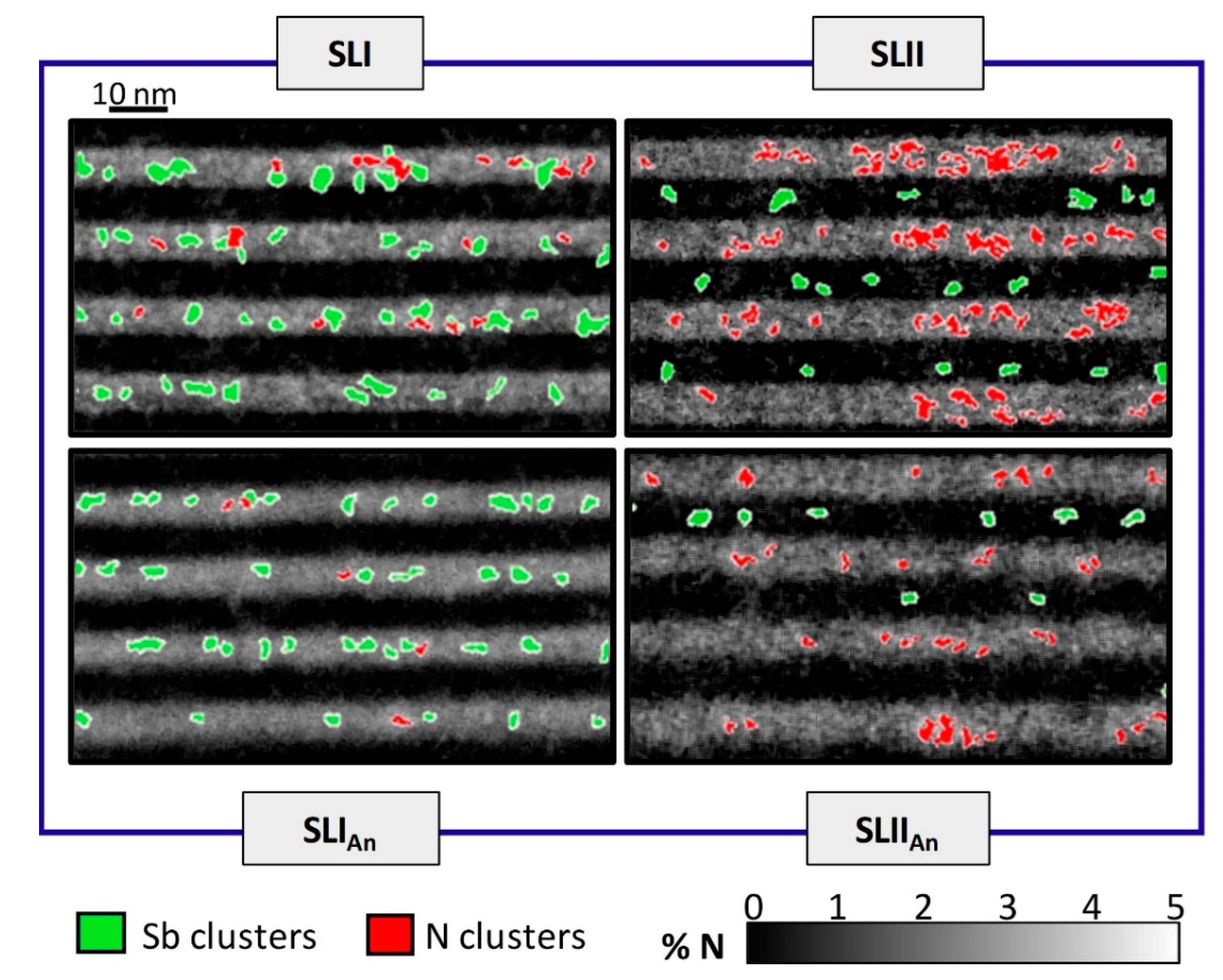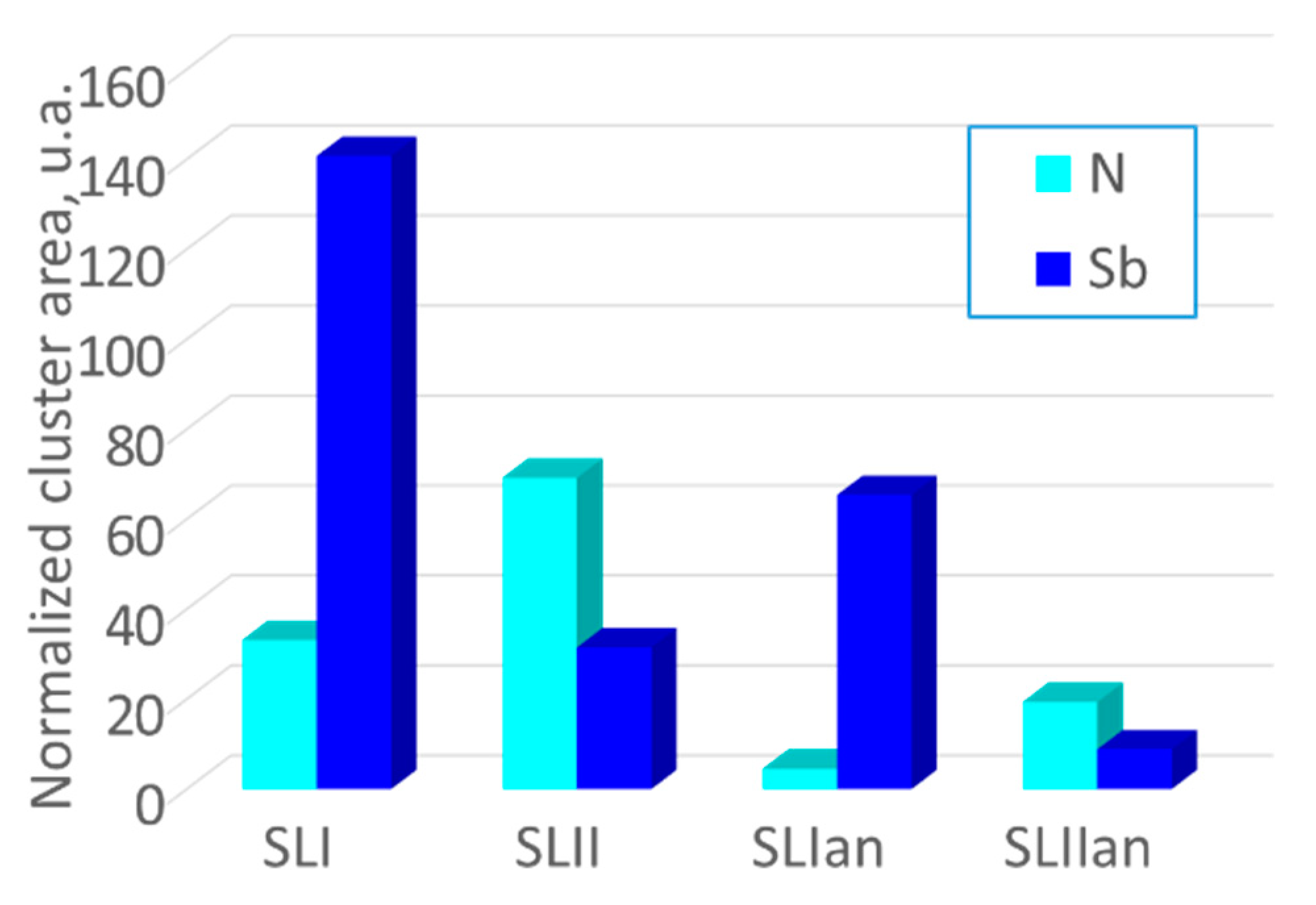Control of Nitrogen Inhomogeneities in Type-I and Type-II GaAsSbN Superlattices for Solar Cell Devices
Abstract
1. Introduction
2. Materials and Methods
3. Results and Discussion
4. Conclusions
Author Contributions
Funding
Conflicts of Interest
References
- Chen, G.; Ning, Z.; Ågren, H. Nanostructured Solar Cells. Nanomaterials 2016, 6, 145. [Google Scholar] [CrossRef]
- Pathi, P.; Peer, A.; Biswas, R. Nano-Photonic Structures for Light Trapping in Ultra-Thin Crystalline Silicon Solar Cells. Nanomaterials 2017, 7, 17. [Google Scholar] [CrossRef] [PubMed]
- Gerbaldi, C.; Galliano, S.; Centore, R.; Massaro, A.; Schiavo, E.; Pavone, M.; Toscanesi, M.; Borbone, F.; Trifuoggi, M.; Carella, A.; et al. Tuning optical and electronic properties in novel carbazole photosensitizers for p-type dye-sensitized solar cells. Electrochim. Acta 2018, 292, 805–816. [Google Scholar]
- Scalia, A.; Bella, F.; Lamberti, A.; Gerbaldi, C.; Tresso, E. Innovative multipolymer electrolyte membrane designed by oxygen inhibited UV-crosslinking enables solid-state in plane integration of energy conversion and storage devices. Energy 2019, 166, 789–795. [Google Scholar] [CrossRef]
- Pydzińska-Białek, K.; Szeremeta, J.; Wojciechowski, K.; Ziółek, M. Insights into the Femtosecond to Nanosecond Charge Carrier Kinetics in Perovskite Materials for Solar Cells. J. Phys. Chem. C 2019, 123, 110–119. [Google Scholar] [CrossRef]
- Green, M.A.; Hishikawa, Y.; Dunlop, E.D.; Levi, D.H.; Hohl-Ebinger, J.; Ho-Baillie, A.W.Y. Solar cell efficiency tables (version 52). Prog. Photovolt. Res. Appl. 2018, 26, 427–436. [Google Scholar] [CrossRef]
- Derkacs, D.; Jones-Albertus, R.; Suarez, F.; Fidaner, O. Lattice-matched multijunction solar cells employing a 1 eV GaInNAsSb bottom cell. J. Photonics Energy 2012, 2, 021805. [Google Scholar] [CrossRef]
- Guina, M.; Wang, S.M.; Aho, A. Molecular Beam Epitaxy of Dilute Nitride Optoelectronic Devices. In Molecular Beam Epitaxy; Elsevier: Amsterdam, The Netherlands, 2018; pp. 73–94. ISBN 9780128121368. [Google Scholar]
- Ungaro, G.; Le Roux, G.; Teissier, R.; Harmand, J.C. GaAsSbN: A new low-bandgap material for GaAs substrates. Electron. Lett. 1999, 35, 1246–1248. [Google Scholar] [CrossRef]
- Gonzalo, A.; Utrilla, A.D.; Reyes, D.F.; Braza, V.; Llorens, J.M.; Fuertes Marrón, D.; Alén, B.; Ben, T.; González, D.; Guzman, A.; et al. Strain-balanced type-II superlattices for efficient multi-junction solar cells. Sci. Rep. 2017, 7, 4012. [Google Scholar] [CrossRef]
- Aeberhard, U.; Gonzalo, A.; Ulloa, J.M. Photocarrier extraction in GaAsSb/GaAsN type-II QW superlattice solar cells. Appl. Phys. Lett. 2018, 112, 213904. [Google Scholar] [CrossRef]
- Zhang, S.B.; Wei, S.-H. Nitrogen Solubility and Induced Defect Complexes in Epitaxial GaAs: N. Phys. Rev. Lett. 2001, 86, 1789–1792. [Google Scholar] [CrossRef]
- Ho, I.H.; Stringfellow, G.B. Solubility of nitrogen in binary III-V systems. J. Cryst. Growth 1997, 178, 1–7. [Google Scholar] [CrossRef]
- Stringfellow, G.B. Thermodynamic considerations for epitaxial growth of III/V alloys. J. Cryst. Growth 2017, 468, 11–16. [Google Scholar] [CrossRef]
- Wang, L.; Elleuch, O.; Shirahata, Y.; Kojima, N.; Ohshita, Y.; Yamaguchi, M. Inhomogeneous nitrogen incorporation effects on the transport properties of GaAsN grown by CBE. J. Cryst. Growth 2016, 437, 6–9. [Google Scholar] [CrossRef]
- Takahashi, M.; Moto, A.; Tanaka, S.; Tanabe, T.; Takagishi, S.; Karatani, K.; Nakayama, M.; Matsuda, K.; Saiki, T. Observation of compositional fluctuations in GaNAs alloys grown by metalorganic vapor-phase epitaxy. J. Cryst. Growth 2000, 221, 461–466. [Google Scholar] [CrossRef]
- Schlenker, D.; Miyamoto, T.; Pan, Z.; Koyama, F.; Iga, K. Miscibility gap calculation for Ga1−xInxNyAs1−y including strain effects. J. Cryst. Growth 1999, 196, 67–70. [Google Scholar] [CrossRef]
- Chauveau, J.-M.; Trampert, A.; Pinault, M.-A.; Tournié, E.; Du, K.; Ploog, K.H. Correlations between structural and optical properties of GaInNAs quantum wells grown by MBE. J. Cryst. Growth 2003, 251, 383–387. [Google Scholar] [CrossRef]
- Grillo, V.; Albrecht, M.; Remmele, T.; Strunk, H.P.; Egorov, A.Y.; Riechert, H. Simultaneous experimental evaluation of In and N concentrations in InGaAsN quantum wells. J. Appl. Phys. 2001, 90, 3792–3798. [Google Scholar] [CrossRef]
- Kong, X.; Trampert, A.; Ploog, K.H. Composition fluctuations in dilute nitride (Ga,In)(N,As)/GaAs heterostructures measured by low-loss electron energy-loss spectroscopy. Micron 2006, 37, 465–472. [Google Scholar] [CrossRef]
- Miyashita, N.; Ahsan, N.; Okada, Y. Effect of antimony on uniform incorporation of nitrogen atoms in GaInNAs films for solar cell application. Sol. Energy Mater. Sol. Cells 2013, 111, 127–132. [Google Scholar] [CrossRef]
- Yuen, H.B.; Bank, S.R.; Wistey, M.A.; Harris, J.S.; Seong, M.-J.; Yoon, S.; Kudrawiec, R.; Misiewicz, J. Improved optical quality of GaNAsSb in the dilute Sb limit. J. Appl. Phys. 2005, 97, 113510. [Google Scholar] [CrossRef]
- Oshima, R.; Huang, J.Y.; Miyashita, N.; Matsubara, K.; Okada, Y.; Ponce, F.A. Transmission electron microscopy study of GaInNAs(Sb) thin films grown by atomic hydrogen-assisted molecular beam epitaxy. Appl. Phys. Lett. 2011, 99, 191907. [Google Scholar] [CrossRef]
- Kudrawiec, R.; Latkowska, M.; Baranowski, M.; Misiewicz, J.; Li, L.H.; Harmand, J.C. Photoreflectance, photoluminescence, and microphotoluminescence study of optical transitions between delocalized and localized states in GaNAs, GaInNAs, and GaNAsSb. Phys. Rev. B 2013, 88, 125201. [Google Scholar] [CrossRef]
- Zhao, Q.X.; Wang, S.M.; Wei, Y.Q.; Sadeghi, M.; Larsson, A.; Willander, M. Effect of growth temperature and post-growth thermal annealing on carrier localization and deep level emissions in GaNAs/GaAs quantum well structures. Appl. Phys. Lett. 2005, 86, 121910. [Google Scholar] [CrossRef]
- Hierro, A.; Ulloa, J.-M.; Chauveau, J.-M.; Trampert, A.; Pinault, M.-A.; Tournié, E.; Guzmán, A.; Sánchez-Rojas, J.L.; Calleja, E. Annealing effects on the crystal structure of GaInNAs quantum wells with large In and N content grown by molecular beam epitaxy. J. Appl. Phys. 2003, 94, 2319–2324. [Google Scholar] [CrossRef]
- Grenouillet, L.; Bru-Chevallier, C.; Guillot, G.; Gilet, P.; Ballet, P.; Duvaut, P.; Rolland, G.; Million, A. Rapid thermal annealing in GaNxAs1−x/GaAs structures: Effect of nitrogen reorganization on optical properties. J. Appl. Phys. 2002, 91, 5902–5908. [Google Scholar] [CrossRef]
- Chauveau, J.-M.; Trampert, A.; Ploog, K.H.; Tournié, E. Nanoscale analysis of the In and N spatial redistributions upon annealing of GaInNAs quantum wells. Appl. Phys. Lett. 2004, 84, 2503–2505. [Google Scholar] [CrossRef]
- Ruiz-Marín, N.; Reyes, D.F.; Braza, V.; Gonzalo, A.; Ben, T.; Flores, S.; Utrilla, A.D.; Ulloa, J.M.; González, D. Nitrogen mapping from ADF imaging analysis in quaternary dilute nitride superlattices. Appl. Surf. Sci. 2019, 475, 473–478. [Google Scholar] [CrossRef]
- Braza, V.; Reyes, D.F.; Gonzalo, A.; Utrilla, A.D.; Ulloa, J.M.; Flores, S.; Ben, T.; González, D. Compositional inhomogeneities in type-I and type-II superlattices for GaAsSbN-based solar cells: Effect of thermal annealing. Appl. Surf. Sci. 2018, 459, 1–8. [Google Scholar] [CrossRef]
- Reyes, D.F.; Braza, V.; Gonzalo, A.; Utrilla, A.D.; Ulloa, J.M.; Ben, T.; González, D. Modelling of the Sb and N distribution in type II GaAsSb/GaAsN superlattices for solar cell applications. Appl. Surf. Sci. 2018, 442, 664–672. [Google Scholar] [CrossRef]
- Duschek, L.; Beyer, A.; Oelerich, J.O.; Volz, K. Composition determination of multinary III/V semiconductors via STEM HAADF multislice simulations. Ultramicroscopy 2018, 185, 15–20. [Google Scholar] [CrossRef]
- Hu, Y.; Wang, Z.; Fan, X.; Li, J.; Gao, A. Material microstructures analyzed by using gray level Co-occurrence matrices. Chin. Phys. B 2017, 26, 098104. [Google Scholar] [CrossRef]
- Haralick, R.M.; Shanmugam, K.; Dinstein, I. Textural Features for Image Classification. IEEE Trans. Syst. Man. Cybern. 1973, 6, 610–621. [Google Scholar] [CrossRef]
- Gonzalo, A.; Stanojević, L.; Utrilla, A.D.; Reyes, D.F.F.; Braza, V.; Marrón, D.F.; Ben, T.; González, D.; Hierro, A.; Guzman, A.; et al. Open circuit voltage recovery in GaAsSbN-based solar cells: Role of deep N-related radiative states. Sol. Energy Mater. Sol. Cells 2019, 1–18, in review. [Google Scholar]
- Gonzalo, A.; Aeberhard, U.; Alén, B.; Fuertes Marrón, D.; Utrilla, A.D.; Llorens, J.M.; Guzmán, Á.; Hierro, A.; Ulloa, J.M. Type-II GaAsSb/GaAsN Superlattice Solar Cells, Proceedings of the Physics, Simulation, and Photonic Engineering of Photovoltaic Devices VII, San Francisco, California, USA, 16 February 2018; Freundlich, A., Sugiyama, M., Lombez, L., Eds.; SPIE: Bellingham, WA, USA, 2018; p. 13. [Google Scholar]




| ASM (uniformity) | Correlation | IDM (homogeneity) | Entropy | |
|---|---|---|---|---|
| SLI | 0.71 | 2.29 | 238.3 | 7.82 |
| SLIan | 1.26 | 4.55 | 262.6 | 7.27 |
| SLII | 0.42 | 1.29 | 200.6 | 8.40 |
| SLIIan | 0.60 | 1.84 | 215.4 | 7.96 |
© 2019 by the authors. Licensee MDPI, Basel, Switzerland. This article is an open access article distributed under the terms and conditions of the Creative Commons Attribution (CC BY) license (http://creativecommons.org/licenses/by/4.0/).
Share and Cite
Ruiz, N.; Braza, V.; Gonzalo, A.; Fernández, D.; Ben, T.; Flores, S.; Ulloa, J.M.; González, D. Control of Nitrogen Inhomogeneities in Type-I and Type-II GaAsSbN Superlattices for Solar Cell Devices. Nanomaterials 2019, 9, 623. https://doi.org/10.3390/nano9040623
Ruiz N, Braza V, Gonzalo A, Fernández D, Ben T, Flores S, Ulloa JM, González D. Control of Nitrogen Inhomogeneities in Type-I and Type-II GaAsSbN Superlattices for Solar Cell Devices. Nanomaterials. 2019; 9(4):623. https://doi.org/10.3390/nano9040623
Chicago/Turabian StyleRuiz, Nazaret, Verónica Braza, Alicia Gonzalo, Daniel Fernández, Teresa Ben, Sara Flores, José María Ulloa, and David González. 2019. "Control of Nitrogen Inhomogeneities in Type-I and Type-II GaAsSbN Superlattices for Solar Cell Devices" Nanomaterials 9, no. 4: 623. https://doi.org/10.3390/nano9040623
APA StyleRuiz, N., Braza, V., Gonzalo, A., Fernández, D., Ben, T., Flores, S., Ulloa, J. M., & González, D. (2019). Control of Nitrogen Inhomogeneities in Type-I and Type-II GaAsSbN Superlattices for Solar Cell Devices. Nanomaterials, 9(4), 623. https://doi.org/10.3390/nano9040623






